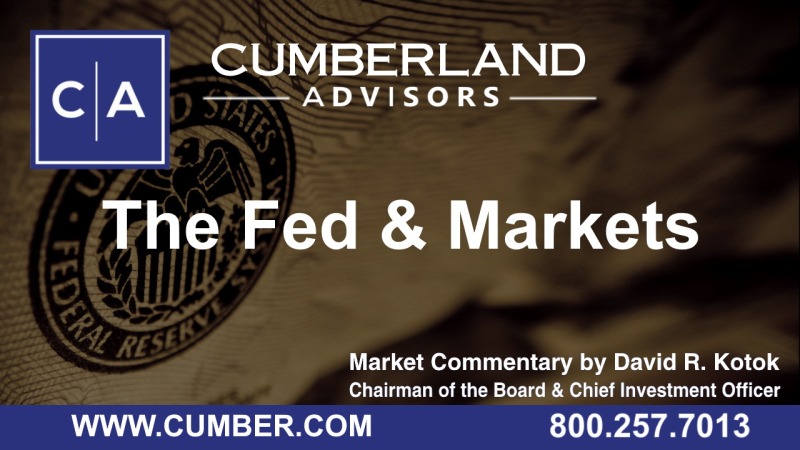My colleague Bob Eisenbeis has written about the forthcoming Federal Reserve appointments and about the FDIC and how important these positions are to the financial community of the United States and the rest of the world. Here’s his discussion: https://www.cumber.com/market-commentary/financial-appointments.

Bob has covered the appointments issues, so there is nothing for me to add there. Below I add a number of related bullets concerning things that may impact financial markets.
1. The Fed has to try to engineer a soft landing. This is a hugely difficult task, and history does not reflect kindly on past attempts to do this. In our opinion the Fed will make this even more difficult by trying to raise interest rates and concomitantly reduce the size of the balance sheet. Simultaneity doesn’t double the risk since the results may be geometric and not arithmetic.
2. The Fed doesn’t know how much of the inflation we see is monetary-induced and how much is a shock response from the pandemic. The Fed doesn’t know the “long and variable lag” time from earlier monetary easing to today’s inflation.
3. The Fed doesn’t have any precise estimate of how large the Fed’s balance sheet should be. In fact, it “should be” different sizes under different circumstances. “Should” is a dangerous word and it is only an opinion.
4. The Fed knows that the balance sheet’s asset size must include enough assets to cover certain liabilities: (a) the needed reserves for the banking system, (b) the amount of currency in circulation, (c) the balance required for US Treasury operations, and (d) a sufficient cushion to absorb shocks to the payments system and to the domicile of worldwide US-dollar liquidity in a secured riskless environment (note: That includes $2 trillion in repo). This is a minimum size.
5. The Fed knows that the real interest rate is very negative, but the Fed doesn’t know what a suitable real interest should be during a post-pandemic-shock recovery. History of all pandemics demonstrates that the real interest rates fall to lower levels after every pandemic. The Fed knows as the San Francisco Fed has studied pandemics and the shock effects from them.
6. The Fed doesn’t know whether there will be another Covid Variant of Concern with a different form after Omicron runs its course. Neither do the rest of us. In fact, an evidence-based analysis would declare that this is year four (2019-2020-2021-2022) of a global pandemic and that we have had the original Wuhan variant and five successive variants, and each of them was different, and each of them created its own version of a shock in economic terms and in terms of hospitalizations and deaths and Long Covid disabilities.
7. The Fed is working on how serious the impact will be when the United States has had two successive years of a decline in life expectancy of about 1.5 years in each of the two years. This is the first time in the history of the Fed that such a shock has occurred.
8. The Fed doesn’t know how many people of labor force age will have temporary, partial, or permanent disability from Long Covid. (Estimates are that between 10 million and 30 million Americans will eventually fall into this category.) If you don’t believe the Long covid story, we suggest you ask any larger employer for experience and anecdotes. Among our clients we are seeing Long Covid effects continually.
9. Is the Fed worried about deaths and their impact on the insurance sector? Last reporting period life insurance companies paid out the highest death benefits since the 1918 pandemic. We will have this year’s numbers in a few months. Anecdote: In a recent online news conference, the CEO of insurance company OneAmerica reported the death rate among working-age adults has risen by 40% since the pandemic began (“Indiana life insurance CEO says deaths are up 40% among people ages 18–64,” https://www.thecentersquare.com/indiana/indiana-life-insurance-ceo-says-deaths-are-up-40-among-people-ages-18-64/article_71473b12-6b1e-11ec-8641-5b2c06725e2c.html). By the March Fed meeting, the financial stress on the life insurers should be more apparent to the Fed and to the rest of us.
So, we have a central bank with massive challenges, and, as my colleague Bob Eisenbeis has noted, it is at 75% of its decision-making bench strength. And if something goes wrong, we need a fully functioning FDIC to make sure we don’t have another banking crisis.
Bottom line: Markets have been celebrating the notion that Omicron will be fast-moving. Once the Omicron surge ends, the markets have been acting as if the economy will be off to the recovery races again with everything working out well. We hope so, but the history of this virus and its impacts shows us that the road ahead will have a few bumps.
Our quantitative work produced a signal to change things, and our US Equity ETF stock market strategy changed from its prior nearly fully invested position. As this is written the US Equity ETF Strategy has a 17% cash position; it was fully invested for most of December.
Below is the best release we can find that outlines the present course of Fed strategy. See the New York Fed’s Markets page, https://www.newyorkfed.org/markets, and in particular its December 15 “Statement Regarding Treasury Securities and Agency Mortgage-Backed Securities Operations,” https://www.newyorkfed.org/markets/opolicy/operating_policy_211215. We would also encourage a careful reading of the Fed’s recently released meeting minutes.
The only thing we know for sure is that we need to be nimble and sharply focused on markets. As of today, the metrics we follow in credit spreads haven’t flashed a warning sign. That’s good. But the bond markets have moved enough to require more intensive analysis.
We must add this note to our clients and to their referring consultants: Any of this may change at any time.
2022 is only just getting started.
David R. Kotok
Chairman & Chief Investment Officer
Email | Bio

